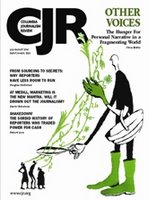
In case you want to know, the PJR Reports (formerly known as the Philippine Journalism Review) is patterned after the highly respected media magazine Columbia Journalism Review (CJR) in the United States.
It's still a long way to go for us before we can reach CJR's status, but I can assure you that we continuously try to improve the quality of the country's version of CJR, assuring that every issue of the PJR Reports is concise, comprehensive, and thoroughly thought out. The latest issue of the PJR Reports, if you can recall my earlier post, is now online.
After reading the PJR Reports issue, you might want to read the July/August 2006 issue of the CJR. Every CJR issue, I must say, is worth reading.

CJR's main story for the July/August 2006 issue zooms in on the fight between the constitutional right of the people to know and the government's right to not to publicly disclose some information, especially those touching on issues affecting national security and terrorism. Go to CJR's site for the stories.
Reading the CJR Daily, which offers "real-time media criticism" from the CJR, is also a pleasant and enriching experience. If you are a journalist who wants to improve your reporting skills, or just a media consumer who wants to see how US media cover, check the CJR Daily site.
Here's an August 29 site entry:
What's More Important -- Plants, or People?
On page four today the New York Times carries an 887-word piece from the Canary Islands -- Spanish territory off the coast of southern Morocco home to unusual evolutionary habitats "that fascinated Charles Darwin more than 100 years ago, and that today reveal a new species or subspecies to scientists an average of once every six days."
While the piece focuses on the local flaura and fauna, and the influx of "invasive species" that are threatening the natural habitat, down in the sixth paragraph the paper explains that the ecological problems the islands are currently suffering from parallel another form of stress: "waves of West African immigrants seeking to reach mainland Europe through the porous borders separating the islands from the rest of the European Union."
Ah, yes, that other immigration crisis -- the one concerning thousands of African migrants perilously traveling hundreds of miles in overcrowded boats -- matters too. ("The flood of destitute Africans making the dangerous journey to the Canary Islands to gain a foothold in Europe is so intense that more have been caught in August than in all of 2005," the Associated Press reports today.)